Mission: Impact podcast & blog
Build a better world without becoming a martyr to your nonprofit cause
Listen on:
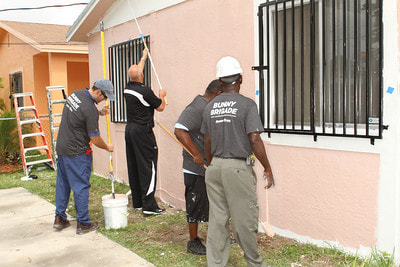 Photo by El Gringo, Miami Habitat for Humanity Photo by El Gringo, Miami Habitat for Humanity Your nonprofit organization is designed for a specific mission with the goal of having an impact in the world. The world will be different in some way because of the work you do. Homeless people are cared for and fed who wouldn’t be otherwise. First generation college students increase their understanding of financial aid so that they can make better decisions about paying for their education. They’d make costly mistakes without you. Emerging leaders in marginalized communities are supported to strengthen their self-awareness and skills so that they can advocate for their community. You undertake the activities and programs with the aim of furthering your mission. Have you taken the time to look at how all the pieces fit together and whether it all adds up? Creating a picture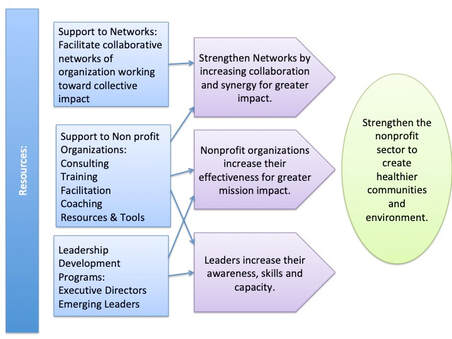 A sample impact map of a capacity building organization. A sample impact map of a capacity building organization. When you create an impact map also known as a logic model, you create a visual representation of what your organization is doing and how it creates the impact you want to have in the world. It makes clear how you leverage resources and organizational capacities to deliver your core strategies to achieve tangible results. By creating an impact map, you are able to create a model that illustrates your beliefs about the change you are trying to make. Identifying assumptions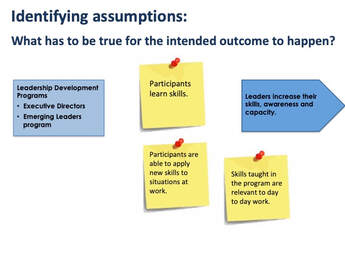 Sample outcomes and indicators. Sample outcomes and indicators. It also can help you uncover the assumptions inherent in your programs and activities. You can also describe what short, medium and long term outcomes you believe result from each program or activity. A good question for identifying assumptions is to ask, “what has to be true for this outcome to happen?” These essentially are the hypotheses embedded in your program design. Are there gaps in logic?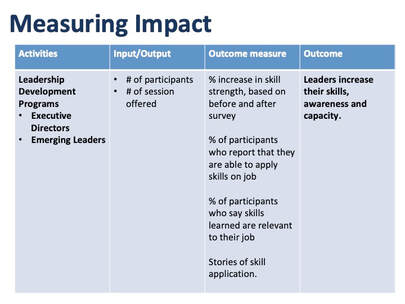 Are you measuring inputs and outputs or outcomes? Are you measuring inputs and outputs or outcomes? Once you have created your map and identified the assumptions inherent with each program, you can consider how you might measure whether you are having the mission impact you are aiming for. An impact map can also uncover gaps in your logic. Creating shared understandingEngaging in the process of impact mapping can be a useful exercise for staff and/or your board. Have small groups create an impact map of your organization. Then compare the maps. Do people envision the same organization? Where are the gaps in knowledge and understanding?
Once you have agreement on your organization’s impact map, take it one step further. Have a conversation about the implications of the map. Ask questions such as:
Think this might be helpful for your organization and would like some help? Inquire about a coaching session.  Photo by Christina Morillo on Pexels Photo by Christina Morillo on Pexels Nonprofit board development is one of those “sharpen the saw” skills that is too easy to let slip. Yet if your organization makes it a habit and builds it into its regular practices, it will serve to keep your board vital and contributing to the organization’s health. BoardSource describes a seven step process for building your board. Identify – The first step is to identify what skills, characteristics and connections are important for your organization. Once you have identified what you need on your board, you can then ask what you have already and what is missing? Where can we find board members to fill identified gaps? Organizations often create a matrix to complete this assessment. Try to go beyond just your current board members networks to recruit board members for greater diversity. Cultivate - You then need to come up with a list of potential people to cultivate that match your needs. Remember to start building a relationship and getting to know the person before you make the ask. How can you help them get to know your organization and keep them informed of your progress? How can you get to know them, their skills, talents and interests? What ways could they become involved with your organization short of board membership? Having stepping stone roles to leadership gives you greater insight into what people bring and their capacities. Recruit - When you go to make the pitch be sure to tell them why you want and need them on your board. How can you make this personal? Be clear about your expectations of board members and their responsibilities. Too often people minimize these requirements thinking it is the only way to get people to say yes. If you minimize the expectations, you will likely get folks who then don’t show up the way you really need them to for your organization. It is also helpful to be able to articulate what benefit they will receive by being involved. This could be skills they are able to develop, relationships and networks they will be able to plug into the satisfaction of being involved in something important. Orient – When new people come on the board, it is key to give them an orientation. This orientation should cover your organization, what it does and how it does things. It also needs to address the key elements of board service. Don’t assume that folks know what being on a board entails. Would a buddy system with a more experienced board member make sense? Beyond just an orientation session, are there ways that you can integrate education into your board meetings? Holding some time for regular education sessions for your whole board will help keep the board’s role front and center with the whole group. 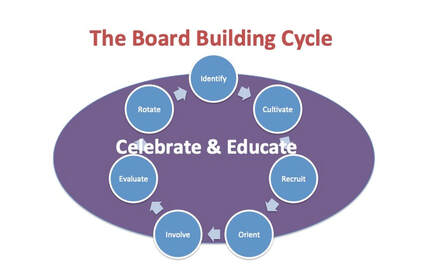 Involve - Once someone has joined your board, how will you go about discovering your board members interests and availability? Do you have committees and task forces that would be supported by their skills and talents? People often volunteer to learn new skills and flex strengths that they do not get to use as much in their day job. Don’t assume because someone does something for a living such as marketing or accounting that that is the role they want to play with your organization. They may want to flex leadership muscles they are not having the opportunity to use at work. How will you solicit feedback on their experience? How will you hold people accountable for what they commit to do? What are additional ways you can express appreciation for what they contribute to your organization? Evaluate – A well functioning board evaluates its work. A good practice is to conduct an annual assessment of its performance. Many nonprofit support centers have template assessments you can use for self-assessment, such as this one. With this regular practice, it serves to remind board members of all aspects of their responsibilities and can help you catch any problems early. Rotate - Strong boards develop new leadership. This is facilitated by policies on term limits and enforced time off the board. Often times board members can re-up for a second term, but don’t let this become an automatic practice. Before re-electing someone for an additional term, consider your matrix of skills/needs. Does this person still fit your requirements? Do you have policies that enable you to ask a board member to resign if they have been inactive and/or missed a certain number of meetings? How are you developing new leadership? Do you have ways for people to get involved and volunteer other than board service? How are you preparing people for the chair role and other officer positions? In addition to these seven, I would add “celebrate” and “educate” as two constants to support your board’s service. Need help with your board, inquire about a free coaching session. |
Archives
April 2024

Grace Social Sector Consulting, LLC, owns the copyright in and to all content in and transcripts of the Mission: Impact podcast, as well as the Mission: Impact blog with all rights reserved, including right of publicity.
|
Telephone301-857-9335
|
info[at]gracesocialsector.com
|
Grace Social Sector Consulting, LLC, owns the copyright in and to all content in, including transcripts and audio of the Mission: Impact podcast and all content on this website, with all rights reserved, including right of publicity.
|